Injection engine - what do we know about it? That is what every modern car is equipped with. The implementation of the resource of such an internal combustion engine (ICE) is designed for economical fuel consumption, minimizing its exhaust into the environment. Let's take a short tour of the unit.
What does he work for?
They work in cycles; each cycle provides an operation:
- Filling fuel cylinders.
- Compressing it with a piston for combustion.
- Working stroke - obtaining mechanical energy by detonating a combustible substance.
- The output of processed raw materials into the atmosphere.
The most demanded by the auto industry are 4-x gasoline-powered. On their example, we will study the principle of operation of the injection engine.
During the first stroke, the piston goes down as much as possible - gasoline mixed with air is supplied through the valve. Further, the piston rises to the stop, closing the valve and compressing the mixture. After that, the candle cuts off the spark - it starts the detonation of the compressed substance.
The increase in temperature in the chamber and the formation of gases move the piston forward, and the crankshaft returns it to the top position due to inertia. At high speeds, the pressure is built up even more, the outlet valve opens. Gasoline processing products rush to it.
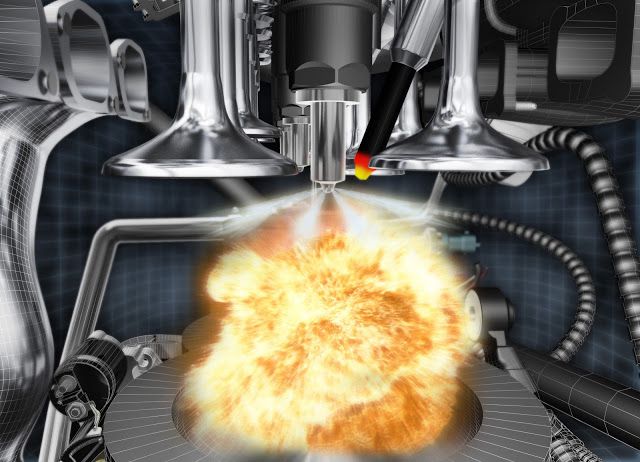
For more rational functioning, a set of sensors is used that determine the load received on the mechanisms, calculate the portions of the components of the detonating mixture to ensure movement with a cycle equal to the clock cycle.
Their software “stuffing” is designed so that each one works in parallel with the motor modes, monitors changes in cycles and adjusts to them. This functionality allows you to adjust fuel consumption to your individual driving style and increase efficiency.
What are the features of the device?
Studying the design will allow you to understand in more detail how the injection engine works. Components specific to this type:
- Electronic control unit (ECU);
- Pressure regulator;
- nozzles;
- Gasoline pump;
- Sensors.
The interaction of the above: sensors receive data on the state of mechanics or processes, they are processed by the processor and transmit control commands. The nozzles are given a limited charge, which opens them. The result is that the mixture from the fuel section enters the intake manifold compartment.
To make the scheme of this process more understandable, let's take a brief tour of the arrangement of some of the nodes that make up the injector engine.
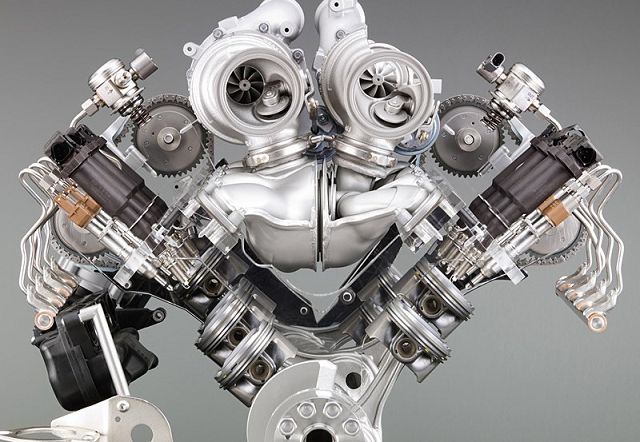
ECU
Its main function is to continuously issue commands to the components of the car based on the processed information. It includes:
- environmental factors (temperature, humidity, etc.);
- the degree of load on the mechanics (when climbing a hill, moving on a bad road, etc.);
- engine mode (idling / high-speed running, taking into account the load when switching to all-wheel drive, etc.).
In case of discrepancies in the original program, the computer sets adjustments to the executing elements. The unit is capable of diagnostics. The driver is notified about the failure of any executor mechanism, its incorrect functioning by indicating the CheckEngine on the dashboard. Information about errors is collected in the memory department, which, in case of serious breakdowns, helps to promptly detect and eliminate them.
Types of embedded memory devices:
- One-time programmable read-only memory (PROM) - contains the basic program code ("brain" of the car). Its chip is located on the panel board; in case of failure, it is easily replaced with a new one. In case of any failures, nested codes remain stored on it.
- Random access memory (RAM) is a temporary reservoir used to process tasks for the current session. The device is soldered to the board; when the power supply from the battery is cut off, all information from it is erased.
- Electrically programmable (EEPROM) - contains temporary data and anti-theft coding. It uses a built-in battery that is recharged while driving. Through it, the sewn-in electronic lock codes and the same immobilizer parameters are compared. If they do not match, the injection engine cannot be started.
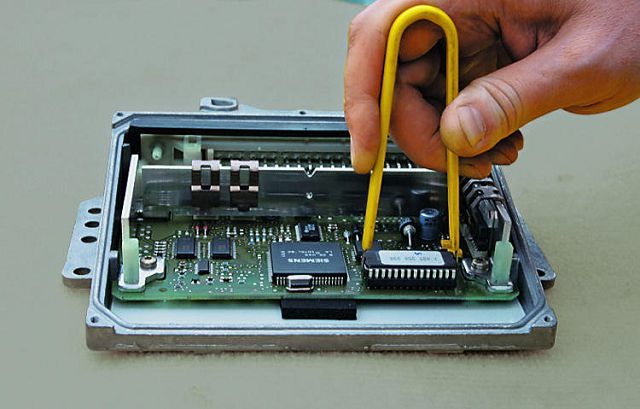
nozzles
Through them, portions of the fuel mass are splashed into the manifold and cylinder compartments, and the opening / closing of the valve is repeated many times within a second.
According to the method of hardware control and the number of parts used, they are divided into categories:
- Throttle Mono Injection (TBI) - the supply of raw materials for detonation is carried out in one piece. The supply jet is not synchronized with the actuation of the inlet valve. The control signals for the injector message are produced from an intra-manifold chip. The principle is common on old motors of the 90s.
- Distribution injection (MFI) - used in all modern cars with an on-board computer. The transfer of fuel is complete: one nozzle - one cylinder. The injector block is mounted on top of the manifold, and the whole process is synchronized with the CBU, according to how the injection engine ignition system works. When comparing the summary characteristics of predecessors - the efficiency increased to 10%.
MFI-elements for jet supply are: electro-hydraulic, electromagnetic, piezoelectric. They are used in the distribution of injection:
- Simultaneous (synchronous filling of all cylinders);
- Pairwise-parallel - one pair of pistons takes the lower position, the other - the upper one. The filling of fuel and the removal of combustion products are carried out in the same way;
- Two-stage (phase) - the transfer of fuel to the combustion chambers is carried out in two operations.
- Directly - it is used in motor designs that involve the combustion of an oxygen-depleted composition.
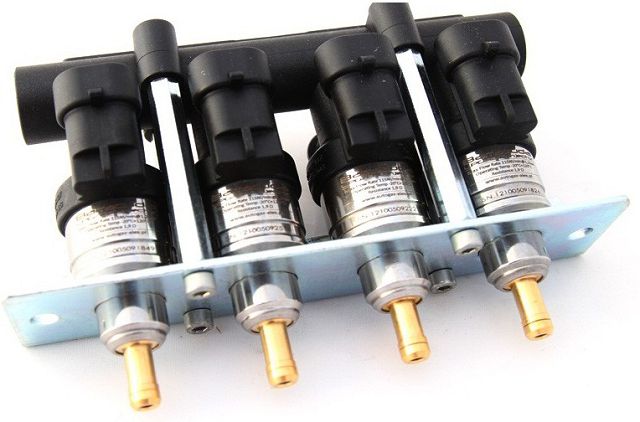
An important fact: TBI technology is practically not common today, as it is less economical and unreliable!
catalytic converter
This device makes it possible to reduce the content of substances such as carbon and nitrogen oxides in the exhaust gases by converting them into hydrocarbons. Not controlled by the ECU, but interacts with the processing center through a sensor that determines the percentage of oxygen in the exhaust accumulations. In case of excessive fuel supply, the controller receives information from the sensor and corrects it.
The converter contains ceramic elements with built-in catalysts:
- oxidizing (platinum and palladium);
- restorative rhodium;
- selective;
- cumulative.
On a note: leaded gasoline is detrimental to the operation of converters, and refueling substances with a high sulfur content will render storage catalytic elements unusable!
Sensors
The well-coordinated work of all mechanisms of injection engines is ensured by the readings of mini-devices fixed on aggregate performers. Each device measures the parameters of the controlled area and transmits them to the computer.
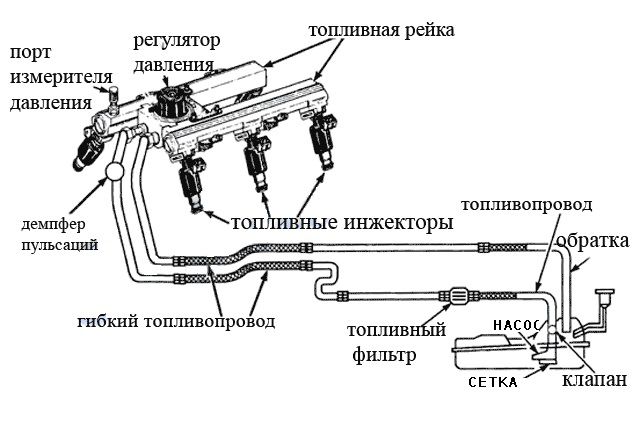
Built-in sensors ® :
- DMRV (R mass air flow) - mounted at the inlet to the air filter. Operates on the principle of comparison of indications. Current flows through 2 platinum filaments. Resistance changes (depends on temperature). In this case, one thread is freely blown, the second is hermetically sealed. Due to the difference that has appeared, the ECU makes a calculation.
- DBP (R absolute pressure and temperature in the engine) - combined or set separately from the previous one. It consists of 2 chambers: one is sealed (vacuum inside), the second is supplied directly to the manifold intake chamber. A diaphragm passes between the chambers, piezoelectric elements are fixed, which create tension when it moves.
- DPKV (R crankshaft position) - is installed in the form of a magnetic comb on the crankshaft pulley. It is equipped with 58 teeth and 2 gaps equal to the tooth pitch. The teeth move in a copper winding, which, when interacting with a magnetized core, forms an inductive voltage - it depends on the speed of the pulley.
- DF (R phase) - contains a disk with a coil and a slot. The slot turns to the device - the output voltage is equalized with zero. At the same time, compression top dead center is reached in the first cylinder. Due to this, the central unit outputs voltage to the desired cylinder for ignition, controls the cycles.
- DD (R detonation) - they are equipped with a cylinder block. At the moment of detonation, vibration passes through it. The transmission of information is based on the generation of free current voltage - it increases with greater vibration.
- TPS (R throttle position) - at a reference voltage of 5 V, it increases or drops due to a change in the rotary angle of the damper.
- DTOZH (R coolant temperature).
- Oxygen sensor - for different designs, it is introduced singly or in pairs. Takes measurements of free oxygen in exhaust products. Its function allows the ECU to determine whether to enrich or lean the fuel mixture.
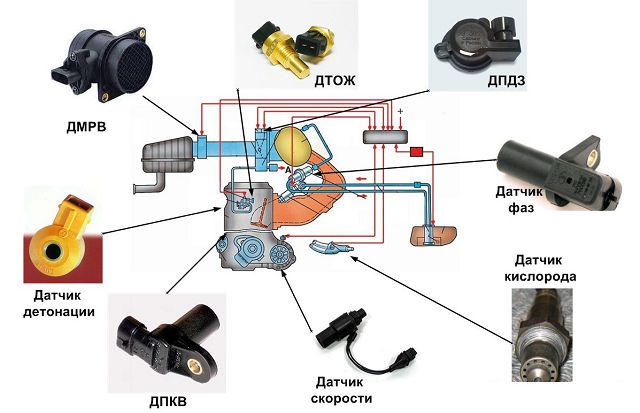
The injector is much better than the carburetor. To verify this, consider a comparison of similar motor structures in the table:







